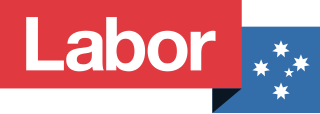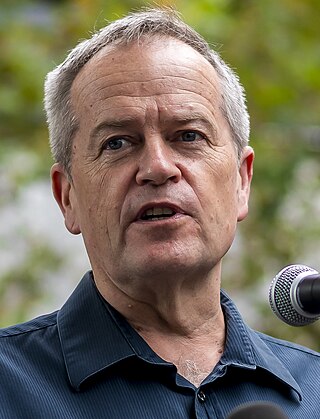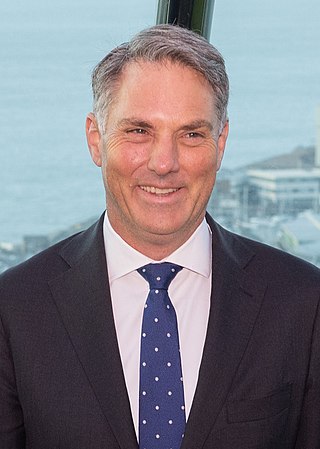Structure
| | This section needs expansion. You can help by adding to it. (February 2012) |
The Australian Labor Party Caucus comprises all the elected members of the Australian Labor Party (ALP) in both Houses of the national Parliament. The Caucus determines some matters of policy, parliamentary tactics, and disciplinary measures against disobedient MPs. It is alternatively known as the Federal Parliamentary Labor Party (FPLP).
The Caucus is also involved in the election of the federal parliamentary leaders from among its members, as well as his or her dismissal. The leader has historically been a member of the House of Representatives, but though by convention a prime minister is the person who has the support of a majority in the House of Representatives, in the ALP all members (including senators) have an equal vote in the election of the leader, who may then become prime minister. Since October 2013, a ballot of both the Caucus and by the Labor Party's rank-and-file members has determined the party leader and the deputy leader. Bill Shorten was the first leader elected under the new system in late 2013. [1] In government, the federal Caucus also chooses the Ministers, with the portfolios then allocated by the Labor Prime Minister.
The word "Caucus" has American roots and was introduced to the ALP by King O'Malley, an American-born Labor member of the first federal Parliament in 1901. In the non-Labor parties, such party meetings are more commonly described as a "party room".
The Caucus is divided along formal factional lines, with most voting taking place on a bloc factional basis, especially in the case of appointments, and may involve cross-factional deals. The two biggest factions are the National Right and the National Left. Each of these factions contains smaller state-based factions, such as (on the Right) the Victorian Labor Unity group and (on the Left) the Victorian Socialist Left. Members who are not associated with either faction are described as Independents. The two main factions hold factional meetings once a week during Parliamentary sitting weeks.
Factional discipline has declined considerably in recent years. During the leadership contest between Kim Beazley and Mark Latham in December 2003, for example, members of both Left and Right were found in the camps of both candidates. Some of the most hostile relations in the Caucus are between members of the same faction: the relationship between Beazley and Simon Crean is one example.
Factional allegiances in the Caucus tend to be closely related to state political loyalties, and also to trade union affiliations. Large unions such as the Australian Workers' Union, the Australian Manufacturing Workers Union and the Shop, Distributive and Allied Employees Association, regard as "theirs" Members and Senators who formerly held office in those unions, or who have received union support in gaining their preselections, and expect them to act in the union's interests.
| | This section needs expansion. You can help by adding to it. (February 2012) |

The Australian Labor Party (ALP), also commonly known as the Labor Party or simply Labor, is the major centre-left political party in Australia and one of two major parties in Australian politics, along with the centre-right Liberal Party of Australia. The party has been in government since being elected at the 2022 federal election, and with political branches in each state and territory, they currently form government in New South Wales, Queensland, South Australia, Victoria, Western Australia, the Australian Capital Territory, and the Northern Territory. As of 2023, Tasmania is the only state or territory where Labor forms the opposition. It is the oldest continuous political party in Australian history, being established on 8 May 1901 at Parliament House, Melbourne, the meeting place of the first federal Parliament.
The Labor Left, also known as the Progressive Left or Socialist Left, is a political faction of the Australian Labor Party (ALP). It competes with the more economically liberal Labor Right faction.

Francis Gwynne Tudor was an Australian politician who served as the leader of the Australian Labor Party from 1916 until his death. He had previously been a government minister under Andrew Fisher and Billy Hughes.

Jennifer Louise Macklin is an Australian former politician. She was elected to federal parliament at the 1996 federal election and served as the deputy leader of the Australian Labor Party (ALP) from 2001 to 2006, under opposition leaders Simon Crean, Mark Latham and Kim Beazley. After the ALP won government at the 2007 election, she held ministerial office under Kevin Rudd and Julia Gillard, serving as Minister for Families, Community Services and Indigenous Affairs (2007–2013) and Minister for Disability Reform (2011–2013). She retired from parliament at the 2019 election.

Martin John Ferguson is an Australian former Labor Party politician who was the Member of the House of Representatives for Batman from 1996 to 2013. He served as Minister for Resources and Energy and Minister for Tourism in the Rudd and Gillard governments from 2007 to 2013.

Brendan Patrick John O'Connor is an Australian politician who has served as Minister for Skills and Training since 2022. He is a member of the Australian Labor Party (ALP) and has served in the House of Representatives since 2001. He held ministerial office in the governments of Kevin Rudd and Julia Gillard from 2007 to 2013, including as a member of cabinet from 2012 to 2013. He was a member of the shadow cabinet from 2013 to 2022.
Robert Charles Grant Sercombe is a former Australian politician who represented the Division of Maribyrnong, Victoria for the Australian Labor Party from March 1996 until his retirement at the 2007 federal election.

Kim John Carr is an Australian former politician who served as a Senator for Victoria between 1993 and 2022. Representing the Labor Party, he was a minister in the Rudd and Gillard governments.
Branch stacking is a term used in Australian politics to describe the act of recruiting or signing up members for a local branch of a political party for the principal purpose of influencing the outcome of internal preselection of candidates for public office, or of inordinately influencing the party's policy.

The leader of the Australian Labor Party is the highest political office within the federal Australian Labor Party (ALP). Leaders of the party are chosen from among the sitting members of the parliamentary caucus either by members alone or with a vote of the party’s rank-and-file membership. The current leader of the Labor Party, since 2019, is Anthony Albanese, who has served as the prime minister of Australia since 2022. There have been 21 leaders since 1901 when Chris Watson was elected as the inaugural leader following the first federal election.

William Richard Shorten is an Australian politician and former trade unionist serving as the current Minister for Government Services and Minister for the National Disability Insurance Scheme since 2022. Previously, Shorten was leader of the opposition and leader of the Australian Labor Party (ALP) from 2013 to 2019. A member of parliament (MP) for the division of Maribyrnong since 2007, Shorten also held several ministerial portfolios in the Gillard and Rudd governments from 2010 to 2013.

Carol Louise Brown, an Australian politician, has been an Australian Labor Party member of the Australian Senate representing the state of Tasmania since 25 August 2005.

The Australian Labor Party National Executive, often referred to as the National Executive, is the executive governing body of the Australian Labor Party, charged with directly overseeing the general organisation and strategy of the party. Twenty members of the National Executive are elected by the party's National Conference, which is the highest representative body of the party's state and territory branches. The other eight members are party ex-officio members.

Lang Labor was a faction of the Australian Labor Party (ALP) consisting of the supporters of Jack Lang, who served two terms as Premier of New South Wales and was the party's state leader from 1923 to 1939. It controlled the New South Wales branch of the ALP throughout most of the 1920s and 1930s. The faction broke away to form separate parliamentary parties on several occasions and stood competing candidates against the ALP in state and federal elections.

Richard Donald Marles is an Australian politician and lawyer serving as the 19th and current deputy prime minister of Australia and the Minister for Defence since May 2022. He has been the deputy leader of the Australian Labor Party (ALP) since 2019, having served as the member of Parliament (MP) for the division of Corio since 2007.

Matthew James Thistlethwaite is an Australian politician. He has been an Australian Labor Party member of the Australian House of Representatives since 2013, representing the electorate of Kingsford Smith. He was formerly a member of the Australian Senate from 2011 to 2013. Since 1 June 2022, Thistlethwaite has served as Assistant Minister for Defence, Veterans' Affairs and the Republic in the ministry of Anthony Albanese.

A leadership election was held in October 2013 to select Kevin Rudd's replacement as leader of the Australian Labor Party and Leader of the Opposition. Bill Shorten was elected party leader, and Tanya Plibersek was later confirmed as deputy leader.
The history of the Australian Labor Party has its origins in the Labour parties founded in the 1890s in the Australian colonies prior to federation. Labor tradition ascribes the founding of Queensland Labour to a meeting of striking pastoral workers under a ghost gum tree in Barcaldine, Queensland in 1891. The Balmain, New South Wales branch of the party claims to be the oldest in Australia. Labour as a parliamentary party dates from 1891 in New South Wales and South Australia, 1893 in Queensland, and later in the other colonies.
The Victorian Labor Party, officially known as the Australian Labor Party and commonly referred to simply as Victorian Labor, is the Victorian state branch of the Australian Labor Party (ALP). The branch is currently the ruling parting in the state of Victoria and is led by Jacinta Allan, who has served concurrently as premier of Victoria since 2023.

The Australian Labor Party held a leadership election on 22 November 2001, following the resignation of Kim Beazley after the party's defeat at the 2001 federal election. Deputy leader and Shadow Treasurer Simon Crean was elected unopposed as Beazley's replacement, thus becoming Leader of the Opposition.